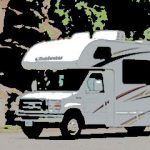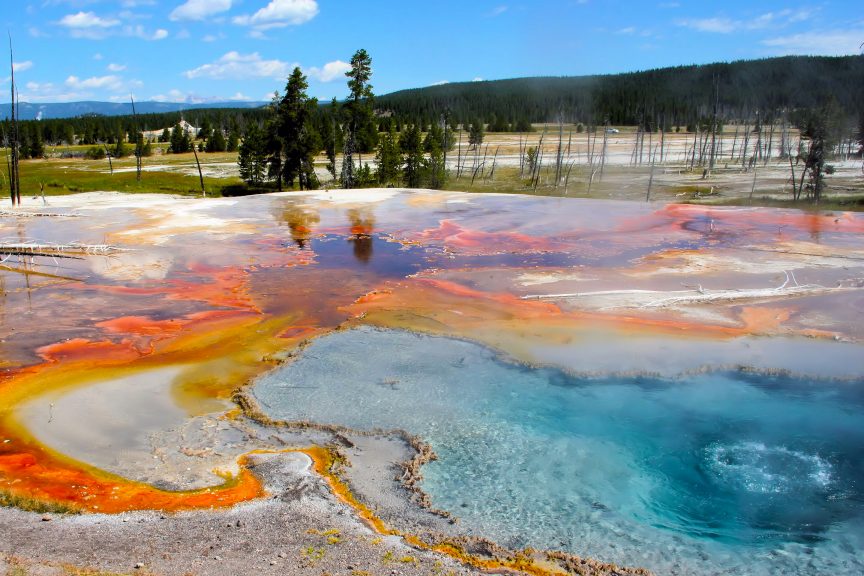Yellowstone National Park is the world’s first National Park. It is located in the states of Montana, Wyoming, and Idaho. (Though it is 96% in Wyoming)
Yellowstone National Park is known for its wildlife and its many geothermal features, especially the Old Faithful Geyser.
Planning Your Trip to Yellowstone National Park
Camping in Yellowstone National Park requires some early planning and a little luck. There are several campground areas to choose from that can accommodate RVs and trailers. When I was in the initial stages of planning the trip to Yellowstone National Park, I was overwhelmed with the vast amount of information out there to process. I needed to ask myself what I wanted:
- What area did I want? (Yellowstone National Park is huge- it’s 3472 sq miles or almost 9000 sq kilometres in size)
- Because attractions and features were quite spread out- what area offered the things I wanted to do?
- How far would I be from other areas of interest?
- Are RV hook-ups available?
There were 3 main areas of interest that we wanted to see:
- Old Faithful and other geysers
- Mammoth Hot Springs
- The Grand Canyon of the Yellowstone River
When I was planning the trip, we did not have a tow vehicle. I was mindful of how driving and parking a 30ft motorhome can be challenging especially when visiting popular destinations.
Campground options:
Fishing Bridge RV Park:
Fishing Bridge RV Park is fairly central within Yellowstone National Park. It is located across from Yellowstone Lake.
Only hard-sided camping units can be accommodated and only up to 40ft. The sites are double wide with limited space for slide outs. Fishing Bridge RV Park offers full hook-ups (the only place in the park that does) but no picnic tables and campfires are not permitted. The sites are very tight.
Mammoth Campground:
Mammoth Campground is just too far away from everything else except the Mammoth Hot Springs, and even then it wasn’t directly accessible. It is located at the top of the park near the North entrance. The campground can only accommodate RVs 30ft or less.
Canyon Campground:
Canyon Campground is near Canyon Village and the Grand Canyon of the Yellowstone. This is a popular area so there are a lot of amenities:
- a visitor centre
- an amphitheatre
- all Yellowstone tours can be accessed from Canyon Village
- There is a bike trail section along North Rim Drive.
Site Review:
Reservations:
When you book a campsite at Yellowstone National Park you do not pre-select your site. And you really must pre-book, the chances of having any available sites if you just show up are pretty slim, especially during peak times. At the time that you make the reservation, you tell them the type of equipment that you have (i.e unit length, tow vehicle etc.) and what campground you are interested in staying at. They assign you a site. Your slide-outs may or may not be accommodated. In our case, it was not possible to open our awning.
We were lucky that we did get a level site, many are not. I’m not sure what system the park staff employ when determining who gets what site because I saw large pull-thru sites with tents on them. You pick your campground and hope for the best! Complaining about your site once you get there would likely be futile. This place is packed. You get what you get.
Grand Teton National Park is right next door to Yellowstone. Some find that camping there and using a Grand Teton/Yellowstone combo day pass to enjoy the amenities and attractions of Yellowstone while avoiding the crowds is a good option.
Campground showers:
Each site comes with a shower card that is issued to you when you check in. It allows each site the equivalent of 2 showers per day. The showers are located in the building directly behind the Canyon campground check-in.
Activities at Yellowstone National Park:
Volumes have been written about things to do at Yellowstone. I think I’m the typical visitor on a road trip. The one who has allotted a couple of days and wants to see the most that they can in that time frame. Be prepared to drive. Be prepared for some long days.
Mammoth Hot Springs
The Grand Canyon of the Yellowstone
The Norris Geyser Basin
The Lower Geyser Basin
The Madison area
Old Faithful/ and the Upper Geyser Basin
The Hayden Valley
There was still so much that we didn’t see.
Things to Know:
Traffic:
Yellowstone National Park is extremely busy! If you have ever wondered where all those CruiseAmerica rental motorhomes are going- I can tell you that it’s probably Yellowstone! Every single parking lot, every single Visitor Centre, and every single turnout is packed. There will be things that you simply will not see because you will not find any place to park.
My best suggestion is to pack your patience and take your chill pill- remember there is no such thing as “too early” to head out.
Cycling:
Cycling on Yellowstone roads is not for the faint of heart. There were camping cyclists touring the park on the main roads and I held my breath every time I saw one. There is virtually no shoulder through most of the park.
Perfect Picture of Lower Falls:
If visiting the Canyon area and you want that picture of the Lower Falls that you see on all the postcards you need to follow North Rim Drive and go to “Lookout Point”. It will just be a short walk from the parking lot.
You want to avoid the “Brink of the Lower Falls” trail. You will see this trail first and you will think that this is where the photo spot is because there will be a lot of people. The “Brink of the Lower Falls” trail is long and it is steep, and it switchbacks several times until you reach the viewpoint then you will realize that you are at the top of the Falls, and while the canyon view is nice you don’t have a view of the falls themselves.
You will curse yourself for being a sheep and blindly following the herd and now knowing that you will have to walk all the way back up and that it was all for nought (just like we did). So skip the “Brink of the Lower Falls” trail and carry on to the next parking area if all you really want is the full view of the Lower Falls.
Wildlife:
I was under the impression before going to Yellowstone that the place is teeming with wildlife- and it is. You will see buffalo as you drive through Hayden Valley for sure, and there is a very good chance that you will see elk around the Mammoth Hot Springs area.
Everything else is entirely dependent on the luck of the day.
Swimming:
We discovered, by chance, along the Firehole Canyon Drive (near Madison) a really pretty spot where the park has set up access stairs and provided some accommodations so that you can swim in the river.
Fishing:
For many casting a line and catching a fish from one of Yellowstone’s streams or rivers is the main purpose of their visit. It should be noted that if this is an activity you wish to participate in you will require a special Yellowstone fishing licence. There are other restrictions and regulations you should brief yourself on prior to your visit.
Driving the Grand Loop:
Before heading out to drive the Grand Loop, you should be aware that one round trip is a minimum of 140 miles. Gas stations are located at various places within the park. There are numerous side drives along the way, not to mention the time spent at each stop. Personally, I don’t think it’s realistic to even see the bare minimum of what Yellowstone has to offer in one day.
Caution around the Geothermal features:
Be sure to mind the warning signs and to stay on the boardwalks and designated paths when visiting the geothermal features.
IMO:
Yellowstone National Park is beautiful. I was really fascinated by the geysers and the thermal activity. It is truly something to see. There is nowhere else on Earth where there is the opportunity to see this much activity in one concentrated area. It was humbling to see the power within this planet. It inspires awe. Having said that, and having experienced a bit of what Yellowstone has to offer, I would not go back- the crowds are that bad.
I read an article in the May 2016 special issue of National Geographic that featured Yellowstone. It talked about capacity crowds and posed the dilemma of whether to limit the number of visitors in order to protect sensitive resources or to allow the number of visitors to continue to grow unchecked and risk irreparable damage. Having witnessed first-hand the idiocy of some people and their blatant disregard for the signs and cautions posted everywhere, as well as their complete lack of appreciation for how special this place is, my vote is for limitations.

